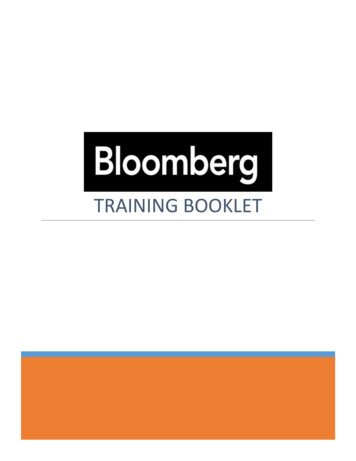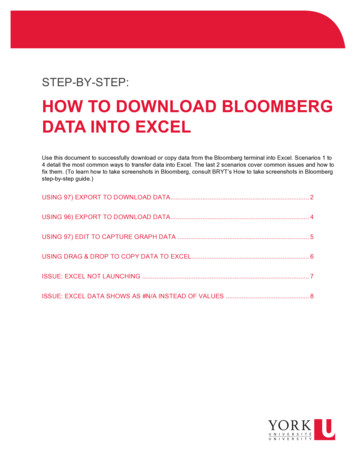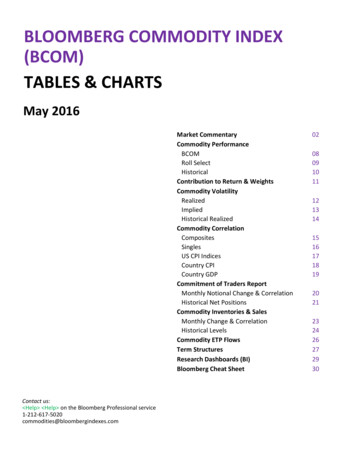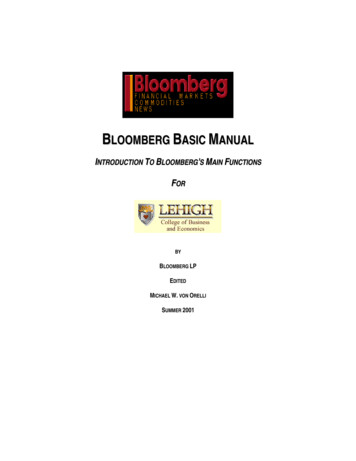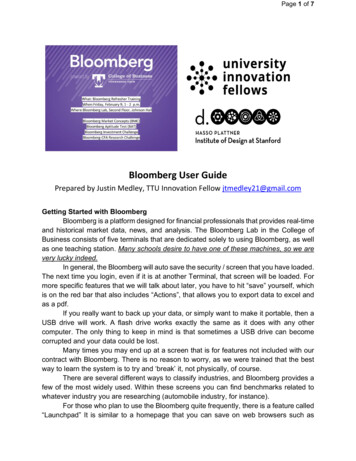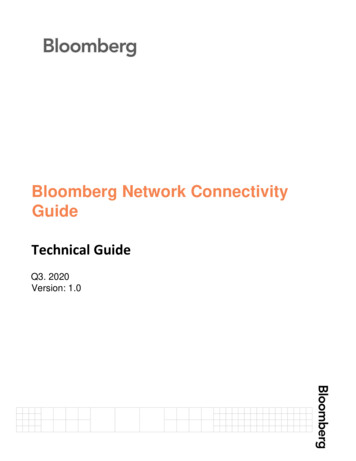
Transcription
Bloomberg Network ConnectivityGuideTechnical GuideQ3. 2020Version: 1.0
Contents1. Overview . 32. Bloomberg Network Access Requirements . 42.1. Access to the Bloomberg Infrastructure via Network Access services . 42.2. Capacity and Bandwidth Requirements – Bloomberg Terminal . 52.3. Network Address Specifications – Bloomberg Terminal . 72.4. Network Ports – Bloomberg Terminal . 72.5. Network Address Specifications – Enterprise and Feeds Products . 82.6. Network Ports – Enterprise and Feeds Products . 82.7. Bloomberg CPE Router . 93. Internet and BRIN (Bloomberg over Reliable Internet) . 103.1. Network Address Specifications . 103.2. Network Ports . 104. SFTP Connectivity . 114.1. Bloomberg SFTP Connectivity Overview . 114.2. IP Proxies and Firewall considerations . 114.3. SFTP URLs, Network Addresses and Ports . 124.4. BVault SFTP . 135. Additional Network Requirements . 145.1. Requirements to Access Content from Web Links on the Terminal . 145.2. Firewalls. 155.3. Virtual Private Network (VPN). 155.4. Socks5 Proxy Server - Bloomberg Terminal Services . 166. Appendix . 176.1. Connectivity Diagrams . 172
1. OverviewThis document provides network and connectivity specifications for Bloomberg products andservices. The information given is intended to make the process of configuring a client systemand network easy and reliable, for both initial setup and regular maintenance. It is intended fordesktop, systems and network administrators, as well as home and/or standalone users.Bloomberg also provides a range of other supplemental documentation on setting up,configuring and maintaining the Bloomberg Terminal. These are available on theDocumentation Support page of the Bloomberg Professional Services website. For furtherinformation on procedures, technical questions, and common troubleshooting steps, visit theFrequently Asked Questions section.For any additional clarification or assistance regarding any of the topics covered here orin other documents, Bloomberg Customer Support is available 24/7 for any queries.Please note that the information provided in this document is for informational purposesonly, is subject to change, and is provided without any representation or warranty, expressor implied, as to the accuracy or completeness of such information. Provision of applicableservices is subject to agreement to the terms and conditions of a definitive final contract. Inthe event of any inconsistency between this information and the terms of a final contract,the terms of the final contract shall govern.3
2. Bloomberg Network Access Requirements2.1. Access to the Bloomberg Infrastructure via Network Access servicesAccess to the Bloomberg infrastructure includes defined connectivity protocols and standards.All applicable configuration parameters are fully tested to work with Bloomberg applicationsand services and are optimized for failover scenarios.Configurations are deployed using automated provisioning tools to eliminate any manualerrors. Bloomberg is unable to support or store any bespoke configurations or modifiedparameters.Bloomberg offers 24/7 customer support that is dedicated to providing a fast and efficient service.By following this model, Bloomberg is able to provide the best possible technical assistance toour clients.Figure 1. below, shows customer access to Bloomberg’s infrastructure using Bloomberg’sNetwork Access service. This access includes connectivity to Bloomberg’s network,and its data centers.Figure 1. Overview of Bloomberg’s Network Access service4
Bloomberg provisions redundant communication circuits among Bloomberg’s data centers.Connectivity to a given customer site requires yet another set of private/leased circuits fromBloomberg’s data centers (usually from the remote node sites depending on geographicallocations) to customer locations.Figure 1. Depicts a model where a Network Access services customer site is connected to thenearest Bloomberg nodes utilizing two redundant circuits. More detailed diagrams can be foundin the appendix.2.2. Capacity and Bandwidth Requirements – Bloomberg TerminalBloomberg support teams determine the size/capacity of these circuits based on the number ofterminals at a given customer location. Table 1 below, shows Bloomberg’s Network Accessguideline.Bloomberg Terminal Network GuidelineTerminalCount 1GbAccess Capacity10 - 30221Gb5 - 10 Mbps31 – 4041 – 5022221Gb1Gb10 - 20 Mbps20 - 50 Mbps51- 100221Gb50 - 100 Mbps100-2502210Gb100 - 1000 Mbps250 24**10Gb100 - 1000 Mbps 5 - 10 MbpsThe bandwidth guideline table is based on statistical analysis of network utilization of existing Bloomberg terminalsacross the global Bloomberg customer base as well as circuit size offering by various telecom service providers.Individual customer connectivity and bandwidth capacity recommendations are made based on continual automatedmonitoring as well as evaluation by Bloomberg customer support personnel.The actual Network Access capacity is subject to availability at the time of the order.For customer sites with 1-9 terminals a single router and circuit with backup through the Internet may be acceptable. Allother customer sites are required to have multiple diverse circuits and dual routers.The bandwidth (bps) recommendations are for a single router. Dual router sites will require double the statedbandwidth.(*) LAN interface duplex set on client’s request OR Auto/Auto if client doesn’t have a preference.(**) more Bloomberg Appliances may be required.Table 1. – Network Access Guideline5
Connectivity from Bloomberg node sites to customer locations terminate at Bloomberg suppliedrouters installed at the customer sites. These are referred to as CPE (Customer PremisesEquipment) routers. Bloomberg support teams work with customer IT staff to install and connectup these routers.Figure 1. Depicts a redundant circuit installation, which in turn requires two Bloomberg CPErouters. Bloomberg CPE routers may also come with an attached server module (except in avery few cases). The combination of the router and server are known as the BloombergAppliance. The server modules are Linux based and are designed to fan out Bloomberg dataservices locally for better WAN circuit utilization. Bloomberg Appliances are installed in pairswhen there are 10 or more Terminals, and are always attached to a pair of CPE routers. SingleBloomberg Appliance deployment (not in pairs) may be implemented for a client's DisasterRecovery (DR) site.Prior to shipping CPE routers and/or Bloomberg Appliances to a customer site, customers willreceive a “Router Survey Document”. In this survey, the customer’s IT personnel specify theIP addresses of the LAN ports (the router Ethernet ports that connect to the client’s LANinfrastructure) of the Bloomberg CPE routers for configuration. Additional technical informationis also discussed and decided on, such as the routing protocols; eBGP (with BFD support),HSRP, VRRP and Static routes for use between Bloomberg CPE routers and the customer’snetwork environment. It is important to note that the Bloomberg CPE routers and BloombergAppliances are entirely owned and operated by Bloomberg and customers must not access orattempt to access the equipment’s configuration.6
2.3. Network Address Specifications – Bloomberg TerminalCustomers must provide IP addresses on which the Bloomberg CPE routers will reside withinthe customer network. These IP addresses, along with any other used to connect to Bloomberg,do not necessarily have to be IANA registered.Table 2. The required IP address ranges to which customers must be able to connect in orderto access Bloomberg Terminal services. Customers must ensure they can route to these IPaddresses, and more specific subnets within these ranges.Bloomberg IP Address .0/21199.105.184.0/2369.184.0.0/16Table 2. Bloomberg IP address ranges2.4. Network Ports – Bloomberg TerminalIn addition to the required IP address ranges, it is also necessary for specific UDP and TCP portranges to be allowed through customer access lists and firewalls. Table 3. Below showsBloomberg’s specific ports. It should be noted that the destination ports specified are the portnumbers that Bloomberg servers listen on at the Bloomberg data centers.The Bloomberg Terminal uses the following source and destination port numbers. Please note,destination is from the client (terminal) perspective.UDP Source PortsUDP Destination Ports48129 – 48137 & 49152 - 65535148129 — 48137TCP Source PortsTCP Destination Ports8194-8395 & 49152 - 6553518194-8395 & 49152 - 6553518194-8395 & 49152 - 6553518194 — 81988209 — 82208290 — 82941Denotes the Microsoft default ephemeral port range used byWindows Vista and later Operating Systems.Table 3. Bloomberg Private Network UDP and TCP Ports7
2.5. Network Address Specifications – Enterprise and Feeds ProductsBloomberg offers a wide range of Enterprise solutions for business needs, which extend beyondthe Bloomberg Terminal. Specific Enterprise solutions are offered in seven business areas:Content and Technology, Decision Support, Client Management, Liquidity and Trading, Risk andPricing, Operations, Regulations and Compliance. For more information on BloombergEnterprise products please ct/enterprise-gateway/In addition, we also offer electronic trading solutions for equities (including futures and options),fixed income, foreign exchange, commodities and many more.For the list of products, please refer to the Bloomberg website. Alternatively, on the Terminal youmay visit BPS GO and browse the left-hand menu to understand more about the differentsolutions we offer our customers.Table 4. lists the IP ranges used for Bloomberg Enterprise / Feeds Product Servers connectingvia Bloomberg Leased/Dedicated lines. Customers must ensure they can route to thesenetworks and more specific subnets within these ranges.Enterprise / Feed Bloomberg Network Address .43.172.0/24Table 4. Bloomberg Enterprise / Feed IP Ranges2.6. Network Ports – Enterprise and Feeds ProductsFeeds products that use FIX connectivity utilize TCP- 8228; SFTP utilize TCP- 22.The Majority of Enterprise / Feeds products establish connectivity via the ports listed below inTable 5.TCP Destination Ports8194-81988228Table 5. Bloomberg Enterprise / Feed TCP Ports** Some of the ports requires Bloomberg Server whitelisting** For detailed source and destination IP/ports information, please contact the product representative or visit theBloomberg website for more info https://www.bloomberg.com/professional/8
2.7. Bloomberg CPE RouterThis section outlines customer network requirements to access the Bloomberg Terminal service viaour Network Access services and CPE router: Ethernet network that supports IP Minimum CAT5e UTP cable from the customer switch, router or firewall to theBloomberg Access Router for 1Gbps connections Multimode fiber only for 10Gbps connections IP address and subnet mask for the local Ethernet interface on the Bloomberg AccessRouter. (Bloomberg will provide an IP address for customers without an existing IPAddress scheme).One or more Bloomberg CPE Routers may be installed at each customer site. Theserouters provide the following benefits: Enhanced Data DeliveryThe Bloomberg CPE router uses the IP network protocol and addressing schemealong with a dynamic access list to receive and deliver data. Seamless IntegrationInstalling a Bloomberg CPE router requires minimal configuration changes and willnot impact the customer network topology or performance. At least a CAT5e/6UTP cable must be run from the customer switch, router or firewall to distributedata to and via the Bloomberg services. SecurityThe Bloomberg CPE Router communicates only to the private Bloomberg Network.This is ensured through dynamic access lists on each Bloomberg CPE Router inaddition to fixed virtual circuit path definitions based on the underlying Data-Linkprotocol TLS.The Bloomberg CPE router may reside outside LAN firewalls to further ensure LAN integrity.The Bloomberg Terminal Software utilizes both UDP and TCP connections (see Table 3.Bloomberg Private Network UDP and TCP Ports) and contains various components andapplications such as Bloomberg API, Tradebook, FX and multimedia that utilize multipleports.In the event of a failure, an alternate path is established on the host end to transportBloomberg data. For locations with multiple Bloomberg CPE Routers and redundant circuits,Bloomberg supports BGP, HSRP, VRRP and static routes for redundancy, provided there is acrosslink connection between the two devices. In a split site scenario where there is nocrosslink between the two Bloomberg routers, Bloomberg will only support BGP for failover.9
3. Internet and BRIN (Bloomberg over Reliable Internet)3.1. Network Address SpecificationsFor Internet and BRIN connections, the customer’s PC must have Internet connectivityand the ability to resolve DNS names in the following ional.com*.btogo.comTable 6. Bloomberg Domains For Internet connections, the customer PC must be able to connect to the followingBloomberg subnets. (See Table 7. Internet and BRIN IP Ranges). BRIN (Bloomberg over Reliable Internet). Bloomberg utilizes various 3rd party Internetpresence providers to improve the Internet connectivity experience and reliability for the terminal.The customer PC must be able to connect to ANY IP address via Bloomberg specified ports.(See Table 8. Bloomberg Internet UDP and TCP Ports). Customers must also ensure they canroute to these networks and more specific subnets within these ranges:Internet / BRIN Bloomberg Network Address 3.0/24208.22.56.0/24208.22.57.0/24Table 7. Internet and BRIN IP Ranges3.2. Network PortsThe customer PC must be able to connect to the following Bloomberg ports:UDP Destination Ports48129-48137TCP Destination Ports8194-81988209-8220, 82288290-8294Table 8. Bloomberg Internet UDP and TCP Ports10
4. SFTP Connectivity4.1. Bloomberg SFTP Connectivity OverviewBB-SFTP enables a set of Bloomberg-provided SFTP accounts to be used fortransferring files. Access to BB-SFTP is restricted to SFTP Users. SFTP Users may usethe Bloomberg Network access or the Internet to access BB-SFTP.Access to BB-SFTP is only permitted from an IP address previously provided by SFTPUsers to Bloomberg; that IP address will be used to create an account-specific IPaddress whitelist. SFTP Users are responsible for configuration changes within their ownenvironments and for ensuring that they make any necessary changes to their firewallsto enable BB-SFTP access.4.2. IP Proxies and Firewall considerationsIn the scenario where SFTP Users are funneling all their SFTP sessions through a fewproxy IPs, they may encounter a per-IP session limit. In this situation, SFTP Users will needto direct their excess SFTP traffic through additional IP proxies as the session limits per IPwill not be raised.SFTP Users may need to make network changes to allow access to the BB-SFTP servers onport 22. (See Table 9 SFTP Server URLs and IP Addresses). Customers must ensure theycan route to these networks and have configured the firewall appropriately in order to connectto Bloomberg’s SFTP servers.11
4.3. SFTP URLs, Network Addresses and net - ional.comInternet - g.combfmb2-sftp.bloomberg.com22Internet Auto FailoverInternet Auto FailoverGlobalChinaBloomberg Network Access Services - (Production)Use IP ProvidedUse IP ProvidedUse IP ProvidedUse IP ProvidedUse IP ProvidedUse IP 3.94.77160.43.94.24160.43.166.58222222222222VIP FailoverVIP FailoverAMER / ASIAAMER / ASIAAMER / ASIAEMEAEMEAEMEATable 9. SFTP Server URLs and IP AddressesFor Internet connectivity, customers are advised to use the DNS sftp.bloomberg.com andnot use IP addresses directly. The IPs are only provided for purposes of adding to a firewall. Inthe event that one server becomes unavailable, sftp.bloomberg.com will always point toanother available server. SFTP Users’ Internet-facing IP addresses need to be whitelisted withBloomberg as described above.Customers connecting via Bloomberg Network Access services should connect to the aboveIP addresses depending on which region they are connecting from. Customers can choose toconnect to a Virtual IP (VIP) for failover, in which case Bloomberg will route customers toavailable SFTP servers in the event of an outage.12
The failover addresses sftp.bloomberg.com and sftp.blpprofessional.com provided inTable 9 above will switch between Bloomberg data centers as needed, with automatic failoverprovided by Bloomberg. Customers are strongly encouraged to use the failover addresses.For further details on this topic, please see - /FTP.pdf4.4. BVault 91.251.7869.191.212.1422 or 30206GlobalTable 10. BVault SFTP13
5. Additional Network Requirements5.1. Requirements to Access Content from Web Links on the TerminalThe Bloomberg Terminal service provides links to selected webpages and this functionality willutilize the default browser on the customer’s PC or otherwise within the customer’s corporateenvironment. The customers locally installed browsers and corporate proxies will govern serviceand display of the web content. The computer must, at minimum have: Internet Access HTTP Port 80 must be allowed to access any proxy server or firewall HTTPS Port 443 must be allowed to access any proxy server or firewallBloomberg news articles from terminal functions such as NH NS1 GO which load web contentinside the Bloomberg application, will use Bloomberg’s browser engine implemented byblpwebview.exe. Bloomberg’s browser engine technology is based on a subset of Google'sChromium project web browser. Each function that requires the display of web content maycreate one or more instances of blpwebview.exe.Bloomberg’s recommendations for successful use of “In Terminal web content” are as follows: Customers should configure Anti-Virus / Security software not to interfere withlaunching and execution of Bloomberg’s blpwebview.exe process. TCP/IP Communication from blpwebview.exe to external networks should bepermitted on the firewall or security software, similar to the policy for the default desktopweb browser. Customers should permit a user agent similar to Google Chrome desktop browser tosend HTTP requests from clients’ PCs. If this is restricted please contact Bloombergsupport teams for further assistance.14
5.2. FirewallsMost customer networks with an outside connection to the Internet will have some form ofsecurity in place, such as a firewall. A firewall may be installed either locally on the customer PC,on the network, or both. In order for customers to access the Bloomberg Terminal with fullfunctionality, their firewall must be set to assume all incoming and outgoing activity from theBloomberg services are safe. The customer’s firewall must allow connectivity on all the ports andaddresses provided in the relevant sections of this document.Should a customer experience any connection loss or slowness to and from the Bloombergservices, the customer firewall will be considered as a likely factor and should be verified in thefirst instance.Bloomberg Terminal's TLS connections are secured using both Client and ServerCertificates. Bloomberg servers do not allow TLS connections from any device which does nothave a valid Client Certificate. SSL interception is not supported.5.3. Virtual Private Network (VPN)Traveling Bloomberg Anywhere users can remotely access the Bloomberg Terminal service ontheir usual desktop PC by remoting into their corporate network using an Internet connection. Toconfigure the application software to connect over a VPN connection, type CONN Go withinthe Bloomberg application to open the Advanced Connection Options. Under the Settings tab,check the Use any local IP address box. The VPN server must be configured to forward thenetwork traffic to the Bloomberg routers on the private network. In some cases, the VPNconnection must also pass through a proxy server; therefore, the proxy settings need to beconfigured as well. The details for this are given in section 5.4.15
5.4. Socks5 Proxy Server - Bloomberg Terminal ServicesFor customers using a SOCKS5 Proxy Server, the Bloomberg Terminal services willcommunicate with the proxy server and the proxy server will in turn communicate to theBloomberg servers.Figure 2. Client to Proxy Server Communication ExampleThe Bloomberg terminal will send TCP communication by default to port 1080 on the SOCKS5Proxy Server. Upon initial connection, the terminal will select the source port for this connection.This destination port 1080 may be different if the proxy server administrator has configured theproxy server to run on a different port. The source ports will be the same as the standardBloomberg source ports (See Table 3. Bloomberg Private Network UDP and TCP Ports andTable 8. Bloomberg Internet UDP and TCP Ports).In order for the Bloomberg software to connect with the proxy server, type CONN GO withinthe Bloomberg application to open the “Advanced Connection Options”. Under the Settingstab, there are two sets of SOCKS5 Proxy Server settings, one for connections using BloombergNetwork Access services and one for connections using the Internet.To allow API connectivity, ensure that “API settings follow terminal settings” in the AdvancedConnection Options, CONN GO is checked. SOCKS 5 Proxy settings can be customized forBBComm in the BBComm Configuration tool. This can be accessed by clicking; Start – Programs– Bloomberg – BBComm Configuration to open the configuration window. Click the SOCKS5button and enter the appropriate DNS or IP addresses.The communication between the SOCKS5 server and Bloomberg is the same as defined in thisdocument for Bloomberg Network Access services and Internet connectivity for the relevantSource and Destination Ports sections. The Source ports used however, will be defined andlimited by the server administrator.16
6. Appendix6.1. Connectivity DiagramsSingle Customer Site – Single CPEFigure 3. Single Site – Single CPE Network Diagram17
Single Customer Site – Dual CPEFigure 4. Single Site – Dual CPE Network Diagram18
Dual Customer Site – Single CPEFigure 5. Dual Site - Single CPE Network Diagram19
Dual Customer Site – Dual CPEFigure 6. Dual Site – Dual CPE Network Diagram20
Connectivity via InternetFigure 7. Connectivity via Internet Network Diagram21
Table 4. Bloomberg Enterprise / Feed IP Ranges 2.6. Network Ports – Enterprise and Feeds Products Feeds products that use FIX connectivity utilize TCP- 8228; SFTP utilize TCP- 22. The Majority of Enterprise / Feeds products establish connectivity via the ports listed below in Table 5.
